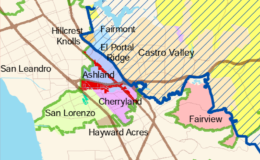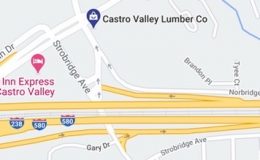It’s reassuring to know that there are other unincorporated communities in California that are trying different solutions to maximize local control. I think we can learn and possibly evolve our own local governance by looking at this different examples of unincorporated governance.
MACs and “MAC Equivalents” Serve 1.4 Million Californians
- By : Michael Baldwin
- Category : Governance, Local Control, Reference Documents
In a blog post from last month, I asked “What is the Castro Valley Municipal Advisory Council (MAC), Anyway?” After a recent Eden Area Livability Initiative Governance Planning Group Meeting, where Alameda County presented a short list of other Municipal Advisory Councils (MACs) around California, I started asking “How many MACs are there in California, anyway?” I knew there had to be other MACs out there, so I conducted a full survey of every California county.

It turns out that the State of California is chock full of MACs and what I am calling “MAC equivalents.” In my 58 county journey, I uncovered a lot of entities that did “MAC-like” things, but weren’t created under the same part of the government code that enabled the creation of our MAC. These “MAC equivalents” are similar to, if not exactly like a MAC in terms of scope and powers. Some of these entities have adivsory planning authority, while others are “General Purpose” only, without an advisory role in “Land-Use” issues like the Castro Valley MAC. Many of these entities, in communities much smaller than Castro Valley, are elected. You can view the entire list of MACs and “MAC equivalents” here, complete with links to their respective web sites (where available.) Here’s what I found in my survey:
- 114 MACs (19 elected) and 67 MAC equivalents (44 elected). That’s a total of 181 local councils representing unincorporated areas throughout California, with 63 of them directly elected by their constituents, representing over 1.4 Million citizens.
- They represented areas that vary in size, from tiny Fish Camp in Mariposa County (population 59) to the mammoth Arden/Arcade area of Sacramento County (population 92,186.).
- Castro Valley ranks fourth in overall population, but it is the largest single area or town underneath a MAC. The three larger areas are multiple communities under a single MAC.
- Out of California’s 58 Counties, MAC and “MAC equivalents” exist in 24 Counties, while 34 have none. Riverside County has the most with 25.
Largest areas by population served by a MAC or equivalent:
- Arden/Arcade – Sacramento County – Population 92,186
- North Highlands/Foothill Farms – Sacramento County – Population 75,815
- Carmichael/Old Foothill Farms – Sacramento County – Population 61.762
- Castro Valley – Alameda County – Population 61,388
Smallest areas by population server by a MAC or equivalent:
- Fish Camp – Mariposa County – Population 59
- Westport – Mendocino County – Population 60
- Pinyon Communities – Riverside County – Population 63
- Creston – San Luis Obispo County – Population 94
I discovered five types of “MAC equivalents”:
- Citizens Advisory Councils (used in Sonoma County) – Set up similar to a MAC, but deals only with land use and planning issues.
- Community Advisory Councils (used in San Luis Obispo County) – Structured the same as a MAC.
- Community Planning Groups (used in San Diego County) – Structured as a MAC to deal with land use and planning issues, but over time has evolved to also deal with some general community issues. All are elected through the traditional ballot process.
- Planning Advisory Committees (used in Mono, Mariposa and Santa Clara Counties) – Structured like a MAC, but specifically tasked with advising their Counties on developing a general plan and maintaining compliance with it in the future. This causes the group to function as a land use oriented MAC, as they deal with the same issues.
- Town Councils (used in Los Angeles County) – An advisory group structured like a general purpose MAC. They do not usually deal with land use issues, but they are not precluded from doing so. All are elected by self funded informal community elections.
These equivalent groups are not technically the same thing as the MACs created under California Government Code 31010. Many were set up long before the traditional MAC was ever defined by the State. Regardless, both the counties and communities involved recognize them as authorized representatives of the unincorporated areas, and thus they receive status and treatment equivalent to a MAC.
Los Angeles County’s Town Councils are a particularly interesting variation. These 17 councils vary from five to 16 elected members. They receive no funding from, and are not chartered by Los Angeles County. They deal with all local general governance issues that a MAC would, and all decisions they make are purely advisory. They work closely with the Los Angeles County Board of Supervisors, and they are regarded by them to be the official voice of the community. Their recommendations are held in high regard. A typical set of by-laws for a Town Council are basically identical to the ones for a MAC. Rather than a traditional election held and overseen by the Registrar of Voters, these Town Councils conduct elections on their own, much like a homeowners association. In Altadena, an unincorporated community above Pasadena in Los Angeles County, the community is divided by eight census tracts. Residents in each census tract elect one member from their census tract to represent them in the Altadena Town Council. Generally, all residents of the area that are over 18 are eligible to vote. The elections take place informally, with “polling places” set up at a particular council meeting, or at convenient locations around town. They are self-funded, so all elections must be paid for by donations, and the cost is kept to a minimum.
I’ll be back next week as I continue my journey exploring the diversity of California MACs and their equivalents.


